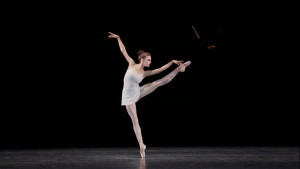I think an appropriate way to close out this ballet blog, after investigating the lives of dancers, ballets of differing contexts, and other relevant ballet topics this year, is a glance at where ballet is today. Ballet has changed with society, culture, and the development of art throughout the past few centuries. Ballet did not stop at classical ballet that created the ballet stereotypes for most of us, characterized by tutus, pointe shoes, precise form, and the feminine ballerina that claimed all of the attention. Contemporary ballet, like modern art, strives to ‘break the rules’ of traditional ballet in ways we’ll explore by examining two contemporary choreographies in particular in addition to the general characteristics of contemporary ballet.
The beginnings of contemporary ballet are contributed to Balanchine for his neoclassical style. Neoclassical ballet preserves the traditional French vocabulary of classical ballet, but diversifies the range of motion available to the dancers.[1] The body isn’t restricted as much to the defined hand and body positions, freeing the dancer to move in more complex, asymmetrical, extreme ways. Faster tempos may be used, reinforcing the severity of quick, intense movements. Hands and feet may be flexed, leotards may be worn instead of tutus, and the presence of a storyline may be left to the interpretation of the audience. The focus is still structure in the dance, accomplished through sophistication, simplification of costumes and sets, and sleek modernization. Neoclassical ballet evolved, diversified, and amplified, eventually leading to ‘contemporary’ ballet that draws on many of the same characteristics taken to greater extremes.
I will honor the father of contemporary ballet (Balanchine) by writing about two ballets that come from his company, the New York City Ballet: Hallelujah Junction and The Cage. These short ballets are not 2-3 hour theatrical productions like the classical ballets I’ve written about; they are only 14-17 minutes long and choreographed to specific pieces of music that inspired the choreographers.
Hallelujah Junction was choreographed by Peter Martins to John Adams’ piano duet of the same name. [2]The ballet has a small cast, consisting of a principal couple each wearing a simple tight white body suit or leotard, a male soloist in black and a small corps de ballet also wearing white and black. The pianists play live in the back, facing each other, on two grand pianos, as the dancers dance in the foreground. As you can see in the following promo video for the ballet, the dance is not strictly classical but does draw on classical moves, taken to some extremes and performed more abstractly.
https://www.youtube.com/watch?v=vredOdAQfCE

The Cage is even more abstract, even wild. Choreographed by Jerome Robbins to Stravinsky’s Concerto in D[3], the ballet incorporates the wildness and even savagery of a figurative Amazon tribe. The novice, the central ‘character’, is a newborn who is learning about her role in the tribe. She has desires, urges, and instincts, but must balance them with her feelings, emotions, and attractions. All dancers, whether male or female, wear tight, tan body-suits with tribal patterns painted in black. The partnering is complicated and gymnastic, and the rest of the choreography diverges from classical form. The following video is an interview with the principal dancer, Wendy Whelan, who I wrote about last semester. I hope you enjoy viewing excerpts from the ballet and comparing it to Hallelujah Junction in the context of contemporary ballet!
https://www.youtube.com/watch?v=JqLmH-f9VOw
Well, it looks like I’ll be signing off from the blogging socialsphere until the next need arises. I have enjoyed writing this blog about an interest I don’t get to tap into much anymore, and I hope you readers have as well. Thank you for reading and commenting your thoughts! Adios, RCL II!
Blessings to all of you,
Carissa
[1] http://www.washingtonballet.org/news-media/ballet-101/
[2] http://www.nycballet.com/Ballets/H/Hallelujah-Junction.aspx
[3] http://www.nycballet.com/Ballets/C/The-Cage.aspx


You may be jumping the gun a bit! We still have one more blog to write!
It sounds so cool that ballet is evolving! I always picture most dance as something static, but that defeats the purpose of dance, doesn’t it? I wonder how these ballets were first received, since they are deviating from what is traditionally “ballet.”
This was a very interesting post! I’m glad you focused on some modern ballets because I honestly didn’t know many people still performed. I’m not a huge fan of theater and dance performances in general, but I think I would be able to sit through a 15-20 performance. The Cage sounds like a really cool performance that would keep my attention with the choreography. I’ll be sure to check out the YouTube video when I’m back in my room!